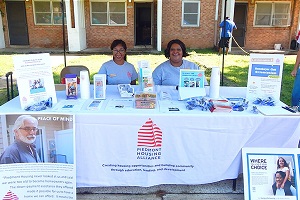 Special to the Philanthropy Journal
Special to the Philanthropy Journal
By Saphira M. Baker, MPA
Strategic planning can be a way for nonprofit leaders to model culture change in their organizations. By disrupting the usual Board-led process and letting staff lead with Board members, a leader signals a fresh approach to planning. This is especially true when staff members’ input shapes a strategic planning document that informs decision-making and organizational priorities for years to come.
 Our practice recently completed strategic plans for two mid-size nonprofits where we adapted a traditional process to allow for much more extensive staff leadership and engagement than we have done in the past. The organizations were quite different from one another – one a local housing agency, and the other a statewide cultural council – yet, in both cases, the executive directors were new and wanted to signal a new approach to planning. Both directors were inheriting organizations where staff were cautious, fearful about change, and concerned about not being heard. Each wanted to emerge from the strategic planning process with a stronger and more cohesive team ready to adapt to changing community needs. We approached each organization differently, with a constant thread being spending significant time understanding and listening to those inside as well as outside the organization.
Our practice recently completed strategic plans for two mid-size nonprofits where we adapted a traditional process to allow for much more extensive staff leadership and engagement than we have done in the past. The organizations were quite different from one another – one a local housing agency, and the other a statewide cultural council – yet, in both cases, the executive directors were new and wanted to signal a new approach to planning. Both directors were inheriting organizations where staff were cautious, fearful about change, and concerned about not being heard. Each wanted to emerge from the strategic planning process with a stronger and more cohesive team ready to adapt to changing community needs. We approached each organization differently, with a constant thread being spending significant time understanding and listening to those inside as well as outside the organization.
With our nonprofit client, our early survey and focus group work confirmed that staff and board members wanted to retain and update four goal areas from the previous strategic plan. At the same time, staff were asking for a greater role in shaping the organization this time around. We worked with the Executive Director and his leadership team to create ad hoc work groups for each strategic goal. Three of the work groups were chaired by staff and brought together cross-functional teams across all business lines. They each recommended actions for their goal through research and a series of three structured meetings. A fourth committee, chaired by a board member, focused in on fundraising and organizational excellence. Each group had full autonomy to create what they believed needed to be done.

Gloria Encinas gives an offers libations to Pachamama during the mesa ceremony. Hundreds, including Gov. Ralph Northam, attended the Virginia Folklife Apprenticeship Showcase at James Monroe’s Highland on Sunday, 5/6/18.
Photo by Pat Jarrett/Virginia Humanities
To facilitate the work within an accelerated six-week timeframe, we provided the committees with meeting templates. They identified gaps, tested and researched solutions, set outcome targets, and created a logical set of strategies to meet the community needs. These four committees came up with ideas that took the organization in a powerful and responsive direction. All of the staff recommendations were accepted and adopted by the board at a joint staff and board leadership retreat, reaffirming the importance of everyone’s voice.
Through this staff-driven committee work, our sense was that many employees had gone from feeling shut out of decision-making to believing they could play a formative role. The executive director had become more connected, was perceived as more trustworthy, and the staff were more open to adapting to change. While success will clearly depend on a continuation of this participatory culture, the collaborative process itself broke with a more hierarchical model of the past.
A natural concern about this staff-intensive approach is that having a staff-driven planning process simply reinforces the current conditions or, worse still, obstructs new ideas. For executive directors, engaging staff effectively requires a delicate balance of communicating priorities early in the process, maintaining the role of the board in approving the final plan, and conveying the expectation that creative and new solutions are needed for a healthy organization.
With our statewide nonprofit council client, staff members were invited to build and critique strategic planning goals, strategies, and documents at regular intervals. As with the earlier client, we conducted an internal staff survey and held early discussions with staff to understand their perspectives. In this organization, the concerns were less about alienation, and more a lack of clarity about how to meld their distinct visions, programs, and priorities into an integrated whole.
 Our aim was to model and encourage effective collaboration by how we organized the strategic planning process. First, we set up a planning committee where Board and staff members shared power equally. Secondly, we shared every key document created by the planning committee in interactive sessions with the senior leadership. As the committee produced new analysis, new sets of findings, or recommendations, we held large group meetings where staff members deliberated together and came up with solutions to get the language and ideas right. Each time, these discussions improved the plan. Staff members’ expertise and unique knowledge of their respective constituencies and programs – while a potential liability for greater cohesion – was an asset in these interactive sessions.
Our aim was to model and encourage effective collaboration by how we organized the strategic planning process. First, we set up a planning committee where Board and staff members shared power equally. Secondly, we shared every key document created by the planning committee in interactive sessions with the senior leadership. As the committee produced new analysis, new sets of findings, or recommendations, we held large group meetings where staff members deliberated together and came up with solutions to get the language and ideas right. Each time, these discussions improved the plan. Staff members’ expertise and unique knowledge of their respective constituencies and programs – while a potential liability for greater cohesion – was an asset in these interactive sessions.
Strategic planning, done well, brings together board and staff around a common vision and creates a renewed sense of purpose. Every executive hopes that, once a strategic plan is adopted, he or she can operationalize the goals and integrate the strategies into the life of the organization. Sharing leadership and direction of the plan early on begins this transitional process well before the planning is complete.
Saphira M. Baker is the founder and principal of her own consulting practice, Communitas Consulting, based in Charlottesville, Virginia. Since 2008, she has had the privilege of working in partnership with over 30 nonprofit, philanthropic, and public sector clients to improve their organizations and communities. She has a Master’s in Public Administration from Harvard’s Kennedy School of Government and a B. A. from Brown University.





